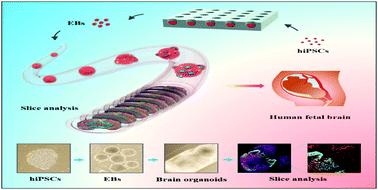当前位置:
X-MOL 学术
›
Integr. Biol.
›
论文详情
Our official English website, www.x-mol.net, welcomes your
feedback! (Note: you will need to create a separate account there.)
A hollow fiber system for simple generation of human brain organoids
Integrative Biology ( IF 1.5 ) Pub Date : 2017-07-28 00:00:00 , DOI: 10.1039/c7ib00080d Yujuan Zhu 1, 2, 3, 4, 5 , Li Wang 1, 2, 3, 4, 6 , Fangchao Yin 1, 2, 3, 4, 5 , Yue Yu 1, 2, 3, 4, 5 , Yaqing Wang 1, 2, 3, 4, 5 , Hui Liu 1, 2, 3, 4, 6 , Hui Wang 1, 2, 3, 4, 5 , Ning Sun 4, 7, 8, 9, 10 , Haitao Liu 1, 2, 3, 4, 5 , Jianhua Qin 1, 2, 3, 4, 5
Integrative Biology ( IF 1.5 ) Pub Date : 2017-07-28 00:00:00 , DOI: 10.1039/c7ib00080d Yujuan Zhu 1, 2, 3, 4, 5 , Li Wang 1, 2, 3, 4, 6 , Fangchao Yin 1, 2, 3, 4, 5 , Yue Yu 1, 2, 3, 4, 5 , Yaqing Wang 1, 2, 3, 4, 5 , Hui Liu 1, 2, 3, 4, 6 , Hui Wang 1, 2, 3, 4, 5 , Ning Sun 4, 7, 8, 9, 10 , Haitao Liu 1, 2, 3, 4, 5 , Jianhua Qin 1, 2, 3, 4, 5
Affiliation

|
3D organoids exhibit near-physiological morphogenesis and histology relying on the self-organization of human pluripotent stem cells (hPSCs), representing a new class of in vitro model for studying developmental biology and diseases. An engineered approach is highly desirable to generate sufficient organoids in a simple and efficient manner. Herein, we present a new strategy for the simple formation of massive human brain organoids from hiPSCs within a hollow fiber reactor system by combining fiber materials with the developmental biology principle. A thin and finely adjustable calcium alginate (CaA) core–shell fiber was constructed using a multilayer coaxial laminar flow microfluidic system. The meter-long hollow fibers enabled neural differentiation of hiPSCs and simple formation of abundant brain organoids in a 3D matrix. The generated brain organoids displayed essential features of human brain organogenesis, including polarized neuroepithelium, cell type heterogeneity and discrete brain regions, resembling the early brain development. This approach is simple and easy to operate, which allows for simplified formation of massive brain organoids, overcoming the tedious procedures in conventional methods. In particular, the facile and scalable characteristics of hollow fibers are compatible with real-time observation and monitoring, as well as flexible tissue manipulations for downstream biological analysis. It might also provide a new platform to advance stem cell-derived organoid models and their utility in biomedical applications.
中文翻译:

一种中空纤维系统,可轻松生成人脑类器官
3D类器官依赖人类多能干细胞(hPSC)的自组织表现出近乎生理的形态发生和组织学,代表了一种新型的体外研究发育生物学和疾病的模型。非常需要一种工程方法来以简单而有效的方式产生足够的类器官。在这里,我们提出了一种新的策略,可以通过将纤维材料与发育生物学原理相结合,从中空纤维反应器系统中的hiPSC轻松形成大量的人脑类器官。使用多层同轴层流微流体系统构建了细且可调节的海藻酸钙(CaA)核-壳纤维。一米长的中空纤维使hiPSC能够进行神经分化,并在3D矩阵中简单地形成丰富的脑器官。产生的大脑类器官显示出人类大脑器官发生的基本特征,包括极化的神经上皮,细胞类型异质性和离散的大脑区域,类似于早期的大脑发育。这种方法简单易行,可以简化大量脑类器官的形成,克服了传统方法中的繁琐程序。特别地,中空纤维的简便和可扩展特性与实时观察和监控以及用于下游生物学分析的灵活组织操作兼容。它还可能为推进干细胞衍生的类器官模型及其在生物医学应用中的实用性提供一个新平台。中空纤维的简便和可扩展特性与实时观察和监控以及用于下游生物学分析的灵活组织操作兼容。它还可能为推进干细胞衍生的类器官模型及其在生物医学应用中的实用性提供一个新平台。中空纤维的简便和可扩展特性与实时观察和监控以及用于下游生物学分析的灵活组织操作兼容。它还可能为推进干细胞衍生的类器官模型及其在生物医学应用中的实用性提供一个新平台。
更新日期:2017-09-18
中文翻译:

一种中空纤维系统,可轻松生成人脑类器官
3D类器官依赖人类多能干细胞(hPSC)的自组织表现出近乎生理的形态发生和组织学,代表了一种新型的体外研究发育生物学和疾病的模型。非常需要一种工程方法来以简单而有效的方式产生足够的类器官。在这里,我们提出了一种新的策略,可以通过将纤维材料与发育生物学原理相结合,从中空纤维反应器系统中的hiPSC轻松形成大量的人脑类器官。使用多层同轴层流微流体系统构建了细且可调节的海藻酸钙(CaA)核-壳纤维。一米长的中空纤维使hiPSC能够进行神经分化,并在3D矩阵中简单地形成丰富的脑器官。产生的大脑类器官显示出人类大脑器官发生的基本特征,包括极化的神经上皮,细胞类型异质性和离散的大脑区域,类似于早期的大脑发育。这种方法简单易行,可以简化大量脑类器官的形成,克服了传统方法中的繁琐程序。特别地,中空纤维的简便和可扩展特性与实时观察和监控以及用于下游生物学分析的灵活组织操作兼容。它还可能为推进干细胞衍生的类器官模型及其在生物医学应用中的实用性提供一个新平台。中空纤维的简便和可扩展特性与实时观察和监控以及用于下游生物学分析的灵活组织操作兼容。它还可能为推进干细胞衍生的类器官模型及其在生物医学应用中的实用性提供一个新平台。中空纤维的简便和可扩展特性与实时观察和监控以及用于下游生物学分析的灵活组织操作兼容。它还可能为推进干细胞衍生的类器官模型及其在生物医学应用中的实用性提供一个新平台。











































 京公网安备 11010802027423号
京公网安备 11010802027423号